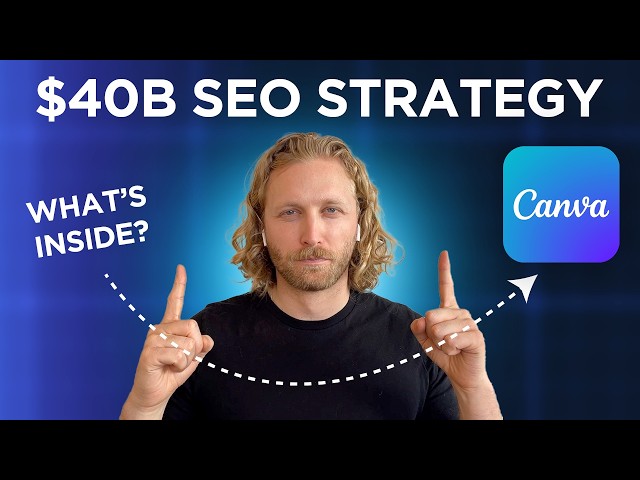In a podcast episode, Cody Schneider and his co-host dive deep into the impressive SEO strategy of Canva, a company valued at $40 billion. They explore how Canva has leveraged SEO from its early days to become a design powerhouse, focusing on unique tactics and the fundamental role SEO plays within the company.
Key Takeaways
- Canva’s $40 billion valuation is significantly supported by its SEO strategy.
- Their core strategy is “product-led SEO,” making the product itself a central part of SEO.
- Creating hundreds of thousands of landing pages targeting long-tail keywords is a key tactic for broad discovery.
- Canva’s template library is strategically designed to target specific keywords and enhance SEO.
- They have dedicated link building specialists who work to acquire links like salespeople work to get sales.
- User engagement is crucial and actively encouraged to boost SEO rankings.
- Translating content into multiple languages has been vital for reaching a global audience.
- Experimenting with new trends, like Zoom backgrounds, shows their adaptability in SEO.
- Providing genuine value and building a trusted brand are fundamental to their SEO success.
Product-Led SEO and Bottom of Funnel Keywords
Cody Schneider and his co-host discuss how Canva’s SEO strategy is deeply integrated with their product, a concept they call “product-led SEO”. Instead of just advertising their product, Canva demonstrates its value directly through SEO. A key part of this involves targeting “bottom of funnel keywords”. They achieve this by creating a massive number of landing pages designed around very specific, long-tail keywords that people search for when they are ready to create designs.
Create Pages and Landing Pages for Discoverability
Canva utilizes “create pages” which function as landing pages for countless design needs. These pages are for everything imaginable, from resumes to social media posts. When someone searches “how to make a poster,” for example, Canva aims to be there, providing an immediate solution. This allows users to experience the product’s ease of use even before signing up, acting as a powerful conversion tactic.
Template Library as an E-commerce SEO Store
The template library is described as an “e-commerce store” for design templates. It is highly organized with categories and subcategories for every possible design need. Canva targets both broad keywords like “invitation templates” and niche keywords such as “Christmas invitation templates” or “baby shower invitations.” This detailed approach ensures they dominate search results across a wide range of design-related searches, capturing a massive audience.
Inspirational Pages and Emotional Connection
Beyond functionality, Canva connects with users emotionally through “inspirational pages”. These pages, filled with ideas like “picture collage ideas” or “Christmas list designs,” tap into the user’s desire for creativity. By offering inspiration, Canva positions itself not just as a tool but as a partner in the creative process, encouraging users to bring their ideas to life using Canva.
Industry-Specific Landing Pages for Targeted Audiences
Canva tailors landing pages for different industries, such as agencies, educators, and small businesses. They understand that different users have different needs. For example, agencies might need social media graphics templates, while educators need presentation or classroom poster templates. By segmenting their audience and providing targeted solutions within the product, Canva enhances user experience and SEO relevance.
Translated Content for Global Reach
A significant aspect of Canva’s SEO strategy is translated content. They make their platform and content accessible in numerous languages, not just English. This global approach has made them a top design tool in countries like Brazil, largely due to their Portuguese platform. Speaking the audience’s language, literally, is crucial for their international success.
SEO Built into the Product DNA from the Start
Cody Schneider and his co-host emphasize that SEO is not an afterthought for Canva; it’s built into the very DNA of their product. The template library is a prime example, carefully curated and categorized to target specific keywords naturally. Each template is essentially a mini SEO asset, contributing to their broad SEO reach across countless design topics and needs.
User Engagement and Feedback Loop
Canva focuses heavily on user engagement, recognizing it as a crucial SEO ranking factor. Active users are more likely to share their designs and link back to Canva, boosting their online presence and SEO performance. This creates a positive feedback loop where product usage drives SEO, and in turn, SEO drives more product usage.
Holistic and Integrated Marketing Approach
Canva’s SEO efforts are integrated into every aspect of their business, not treated as a separate tactic. From product development and content strategy to social media, SEO considerations are woven throughout. This holistic approach is a major factor in their overall marketing success.
Experimentation and Adaptability to Trends
Canva is willing to experiment and adapt to emerging trends to stay ahead in SEO. A prime example is their quick response to the Zoom background trend during the pandemic. They rapidly created a new category of templates and supporting content optimized around “Zoom backgrounds,” capitalizing on the sudden surge in searches for this keyword. This agility is vital in the ever-changing digital landscape.
Proactive Backlink Strategy and Outreach
Canva has a deliberate strategy for earning backlinks, going beyond passively hoping for links. They have a dedicated outreach team that actively seeks opportunities to get their content featured on relevant websites. This proactive approach to link building, including personalized outreach emails, is a testament to their commitment to SEO.
Content as a Core Strategy, Not an Afterthought
For Canva, content is not an afterthought but a core part of their overall strategy. It is deeply integrated into their operations. They continuously analyze, optimize, and refine their SEO tactics based on data, demonstrating a mastery of the ongoing SEO cycle. They play the “long game” in SEO, reaping rewards from consistent, long-term efforts.
Brand Building and User-Friendly Experience
Canva has successfully built a brand synonymous with creativity, ease of use, and accessibility. This strong brand identity significantly impacts their SEO performance. Brand recognition means users are more likely to click on Canva in search results, trust their content, and share their designs, acting as an “SEO multiplier.”
Authenticity and Human Element in SEO
Cody Schneider and his co-host point out that Canva makes SEO feel approachable and even fun by focusing on the human element. Instead of being overwhelmed by algorithms, Canva concentrates on connecting with their audience and providing value. This user-centric approach makes their SEO strategy creative, engaging, and effective.
Conclusion
Cody Schneider and his co-host conclude that Canva’s SEO success stems from building a brand that people genuinely love and trust. By prioritizing user experience and creating valuable content, Canva has achieved remarkable SEO success. Their approach emphasizes authenticity, user-centricity, and a commitment to providing value at every touchpoint, demonstrating that SEO excellence and strong brand building go hand in hand. Canva’s journey is an inspiring example for businesses seeking digital success through a well-integrated and user-focused SEO strategy.
Rating: 7 out of 10.
Difficulty: Very hard. Starting a business like Canva is very hard. It is hard because:
It is hard because:
- Building the website and tool is complex and costs a lot.
- Getting enough people to know about you when Canva is already big is tough.
- Making so many templates and pages like Canva did takes a very long time and effort.
- You need to be very good at SEO, which is hard to master.
- It will take a lot of money to compete with Canva.
Starting a business like Canva is rated as very hard for good reasons.
Due to the high initial costs of building a complex platform, the immense challenge of competing with an established giant like Canva, the extensive time and resources needed to create a comparable library of templates, the difficulty in mastering SEO to gain visibility, and the substantial capital required to compete, you should realistically expect it to take a significant amount of time, likely several years, before you could start seeing meaningful profits.
Initial stages would likely focus on development, user acquisition, and building content, with revenue generation being a longer-term goal in this intensely competitive market.















